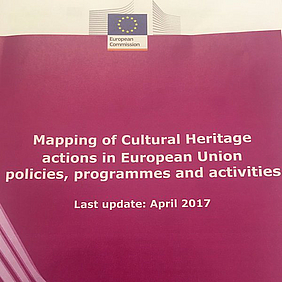This European Commission manual complements the existing policy by explaining further the recent initiatives, changes and opportunities across various fields.
Cultural heritage was recognised by the Council of European Union and the European Comission in 2014 as a strategic resource showing Europe a way towards sustainability. The guide, Mapping of Cultural Heritage actions in European Union policies, programmes and activities, published in April 2017, is user-friendly and easy to follow.
The main aim is to contribute to the development of a strategic approach to the preservation and valorisation of European heritage by providing information on recent policy initiatives and support action undertaken by the European Union in 14 important fields: fields of culture, education, cohesion policy, digital culture, research and innovation, science, internal market, industry, tourism and entrepreneurship, combating illicit trade of cultural goods, competition, common agricultural policy, maritime policy, environment policy, citizenship, external relations and development, European neighbourhood and finally, on rest of the world.
Each field (with the exception of education, cohesion policy, competition and citizenship ) is divided into two subcategories, EU policy/legislation and EU programmes/funding.
The best way to use the manual is to look into the area that interests you and have a look at its policy and funding opportunities. For example, the field of culture is among the most extensively represented areas in the manual.
The section on policy is presented in great detail and divided according to five Priority Areas (Accessible and inclusive culture (A), Cultural heritage (B), Cultural and creative sectors (C), Promotion of cultural diversity, culture etc (D), Cultural statistics (Crossectorial Priority). In the part on funding in culture, three particular programmes are presented. The first is the European Year of Cultural Heritage 2018, followed by the Creative Europe programme (2014-2020) and special actions relevant for the heritage sector are supported under Creative Europe programme. Special actions embrace the already well known initiatives of European Heritage Days, European Capitals of Culture, European Heritage Label and European Union Prize for Cultural Heritage/Europa Nostra Awards.
A useful feature in the manual are links to handbooks and manuals produced within particular policy initiatives, so one can really get a very deep insight into how much work has been done already and what we can expect this year and in 2018.
You can get your copy of the Guide here: http://ec.europa.eu/assets/eac/culture/library/reports/2014-heritage-mapping_en.pdf
Enjoy the reading!
Dijana Pita da Costa is a Slovene archaeologist and a doctoral candidate in Heritology (Heritage) Studies at the University of Ljubljana in Slovenia. She is also IE’s Social Media Coordinator. You can get in touch with her at: dijanapitacosta@gmail.com
To cite this article:
Pita da Costa, Dijana (2017) ‘Mapping of Cultural Heritage actions in European Union policies, programmes and activities’. In Interpret Europe Newsletter 3-2017, 21.




